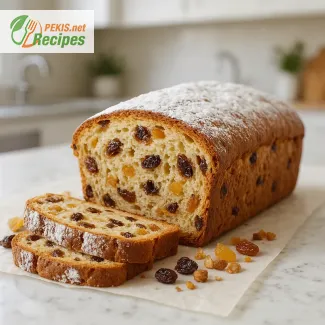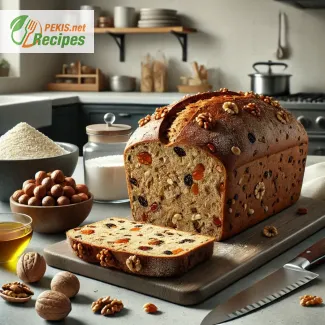Serves 4, with 25 minutes prep, 20 minutes baking, and ready in 45 minutes total, this St. Nicholas breakfast delivers a golden spiced bread filled with raisins, almonds, and citrus zest. Topped with melted dark chocolate, a dusting of sugar, and served with honey and fresh oranges, it balances richness with festive brightness. The dough stays soft for 2 days at room temperature, freezes up to 2 months, and reheats perfectly at 150 °C (300 °F) for 8–10 minutes, making it ideal for advance preparation and holiday gatherings.
PEKIS – professional chef and recipe developer with more than 25 years of experience in cooking and baking, specialized in European and international cuisine. For this St. Nicholas breakfast, I drew on traditions from Central Europe where festive breads, spices, and nuts bring families together, creating a warm morning ritual that blends flavor with meaning.

Festive morning traditions for St. Nicholas
A warm celebration to start the holiday season
The magic of St. Nicholas breakfast lies in its ability to transform a simple morning into a festive ritual. Families across Europe and beyond celebrate December 6th with a table filled with seasonal flavors, cozy aromas, and symbolic treats that bring joy to children and adults alike. The essence of this breakfast is not just in the food itself but in the atmosphere it creates: a blend of tradition, generosity, and anticipation of the coming Christmas season.
The centerpiece of a perfect St. Nicholas breakfast often includes warm pastries, spiced breads, and fruits that symbolize abundance. Chocolate figures of St. Nicholas or small gingerbread cookies may find their place next to steaming mugs of cocoa or mulled drinks. By combining comforting textures with sweet and slightly spiced flavors, this meal captures the heart of the holiday spirit.
The cultural background of St. Nicholas breakfast
The tradition of celebrating St. Nicholas traces back to Central and Northern Europe, where children would leave shoes by the door to be filled with small gifts, nuts, and sweets. Over time, this evolved into a morning gathering where families share a special breakfast together. The foods chosen often reflect local customs: in Germany, rich bread rolls or Stutenkerl pastries; in the Netherlands, spiced speculaas; in Central Europe, dried fruits and honey pastries. Each variation speaks of a shared cultural heritage built around kindness and sharing.
Why you will love this festive breakfast
- Creates a warm, family-centered atmosphere
- Combines sweet and spiced flavors perfect for winter mornings
- Flexible and adaptable to different traditions
- Brings together symbolic foods with a story behind them
- Easy to prepare in advance for a stress-free morning
Ingredients and their role in creating balance
A festive breakfast spread thrives on the right balance of textures and flavors.
- Yeast doughs provide a soft, airy base that pairs beautifully with spreads and toppings.
- Spices like cinnamon, nutmeg, and cloves give depth and a seasonal aroma that defines the celebration.
- Chocolate and nuts add indulgence and crunch, often used in figurines or fillings.
- Citrus fruits and dried fruits bring brightness and a natural sweetness that balance richer pastries.
- Warm drinks such as cocoa, coffee, or lightly spiced milk anchor the meal and create a comforting finish.
Creative variations to inspire your table
- Replace classic gingerbread with chocolate-dipped biscotti for a modern touch.
- Add a savory platter with cheeses and cured meats to balance the sweetness.
- Prepare mini spiced muffins that can be enjoyed warm from the oven.
- Offer a fruit compote or citrus salad to refresh the palate.
- Include small surprise elements, such as wrapped chocolates hidden under napkins, to keep the playful spirit alive.
Storage and make-ahead preparation
- Store pastries at room temperature for up to 2 days in an airtight container.
- Freeze for up to 2 months and reheat when needed.
- Warm in the oven at 150 °C (300 °F) for 8–10 minutes to bring back the fresh-baked texture.
Enriched traditions with meaningful entities
Celebrating St. Nicholas morning means weaving together holiday rituals, family heritage, and seasonal ingredients. Every dish carries a symbolic meaning, from the sweetness of honey to the richness of nuts, reflecting prosperity and kindness. The breakfast table becomes not only a place to eat but a stage where stories, folklore, and warmth are shared across generations.
- Warm the milk gently until lukewarm, then dissolve the fresh yeast and 1 tsp of sugar. Let rest for 10 minutes until frothy.
- In a large bowl, combine flour, remaining sugar, salt, spices, and lemon zest.
- Add the yeast mixture, eggs, and softened butter. Knead the dough for about 8–10 minutes until smooth and elastic.
- Cover with a clean towel and let rise for 1 hour until doubled in size.
- Gently knead in raisins and chopped almonds. Shape the dough into a loaf or small rolls.
- Place on a baking tray lined with parchment paper. Let rise again for 30 minutes.
- Preheat oven to 180 °C (356 °F) and bake for 20 minutes until golden brown.
- Once cooled slightly, drizzle with melted dark chocolate (decoration), dust with powdered sugar, and serve with honey and fresh orange slices.
FAQ questionWhat should a traditional St. Nicholas breakfast include?
A classic St. Nicholas breakfast highlights spiced bread or sweet rolls, nuts and raisins, citrus (zest or fresh slices), and small chocolate treats. Many families add honey, powdered sugar, and a warm drink such as cocoa or milk with a hint of cinnamon. The goal is a table that feels festive, cozy, and symbolic, balancing gentle sweetness with seasonal spice.
FAQ questionCan I prepare everything the night before?
Yes—most elements are make-ahead. Bake the bread or rolls the previous evening, cool completely, then store airtight at room temperature (up to 2 days). Pre-slice oranges, portion honey and chocolate for quick plating, and set the table. In the morning, reheat at 150 °C (300 °F) for 8–10 minutes to revive the just-baked aroma and softness.
FAQ questionHow do I keep the bread soft and fresh?
Focus on proper kneading, full first and second rise, and avoiding over-baking. After cooling, store in an airtight container or wrap in a clean towel to protect moisture. For longer storage, freeze up to 2 months, then thaw wrapped at room temperature and reheat briefly to restore a tender crumb and aromatic spice notes.
FAQ questionWhich spices work best—and how strong should they be?
Use cinnamon as your anchor, then layer nutmeg and a pinch of clove for depth. Add lemon zest for brightness that lifts the sweetness. Keep spices balanced: you want a warm fragrance, not bitterness. If unsure, start light and build up—the sweetness from raisins, honey, and chocolate will round out the profile.
FAQ questionHow can I adapt it for gluten-free, dairy-free, or egg-free diets?
Choose a reliable gluten-free flour blend and add a small amount of xanthan gum for structure. Swap dairy with plant-based milk and vegetable margarine or coconut oil. For eggs, use a flax “egg” (ground flax + water) to maintain moisture. You’ll still get a soft, aromatic crumb with the same seasonal spices and fruit.
FAQ questionWhat should I serve alongside to balance sweetness?
Pair the spiced bread with a savory board (mild cheeses, lightly cured meats) for contrast, plus a fresh citrus salad or fruit compote for acidity. Offer yogurt or a lightly sweetened ricotta to add creaminess. For drinks, serve hot cocoa, coffee, or warm milk with cinnamon to amplify the cozy, festive feel.
FAQ questionCan I bake the rolls in an Air Fryer?
Yes—shape smaller rolls, proof until puffy, and bake in a preheated Air Fryer at a moderate setting, checking early to prevent over-browning. The circulating heat yields a golden crust while keeping the interior soft and fluffy. Finish with melted dark chocolate or a light powdered sugar dusting for that St. Nicholas touch.
A St. Nicholas breakfast brings together more than just food—it is a moment where tradition, flavor, and togetherness merge into one meaningful ritual. By choosing ingredients that balance sweetness, spice, and freshness, every element on the table contributes to a warm seasonal atmosphere that makes the morning unforgettable.
The combination of soft bread, aromatic spices, nuts, and citrus reflects centuries of customs while also leaving space for creativity and personalization. Whether served with dark chocolate drizzle, a touch of honey, or slices of fresh oranges, the result is a festive spread that feels indulgent yet approachable.
What makes this celebration special is its adaptability. Families can adjust the recipe to their preferences—creating a gluten-free, dairy-free, or even egg-free version—while still maintaining the rich flavor and holiday spirit that define the tradition.
By preparing in advance and knowing how to store and reheat, this breakfast becomes not only a festive centerpiece but also a practical, time-friendly tradition. The joy it delivers is lasting, linking cultural heritage with a comforting modern table that shines every December.
Allergens present in the recipe
- Gluten (wheat flour)
- Eggs
- Milk (butter, milk)
- Tree nuts (almonds)
Tips for substitutions to remove allergens and gluten
- Replace wheat flour with a gluten-free flour blend (same quantity) and add 1 tsp xanthan gum for better structure.
- Use plant-based milk (almond milk or oat milk) instead of cow’s milk.
- Replace butter with margarine or coconut oil for a dairy-free option.
- Omit almonds or substitute with pumpkin seeds or sunflower seeds.
- Replace eggs with flaxseed gel (1 tbsp ground flaxseed + 3 tbsp water per egg).
- Vitamin B1 (Thiamine) 0.3 mg – supports energy metabolism and nervous system.
- Vitamin B2 (Riboflavin) 0.2 mg – contributes to healthy skin and vision.
- Vitamin B6 0.25 mg – aids protein metabolism and immune function.
- Vitamin E 2.1 mg – protects cells from oxidative stress.
- Calcium 60 mg – important for bone and teeth strength.
- Magnesium 40 mg – supports muscle and nerve function.
- Potassium 220 mg – regulates fluid balance and blood pressure.
- Iron 2.1 mg – essential for oxygen transport in the blood.
- Zinc 1.2 mg – boosts immune defense and cell growth.
- Polyphenols (from dark chocolate) 250 mg – reduce inflammation and improve heart health.
- Flavonoids (from raisins and oranges) 180 mg – support blood circulation and reduce oxidative damage.
- Vitamin C (from oranges) 45 mg – strengthens the immune system and enhances iron absorption.





